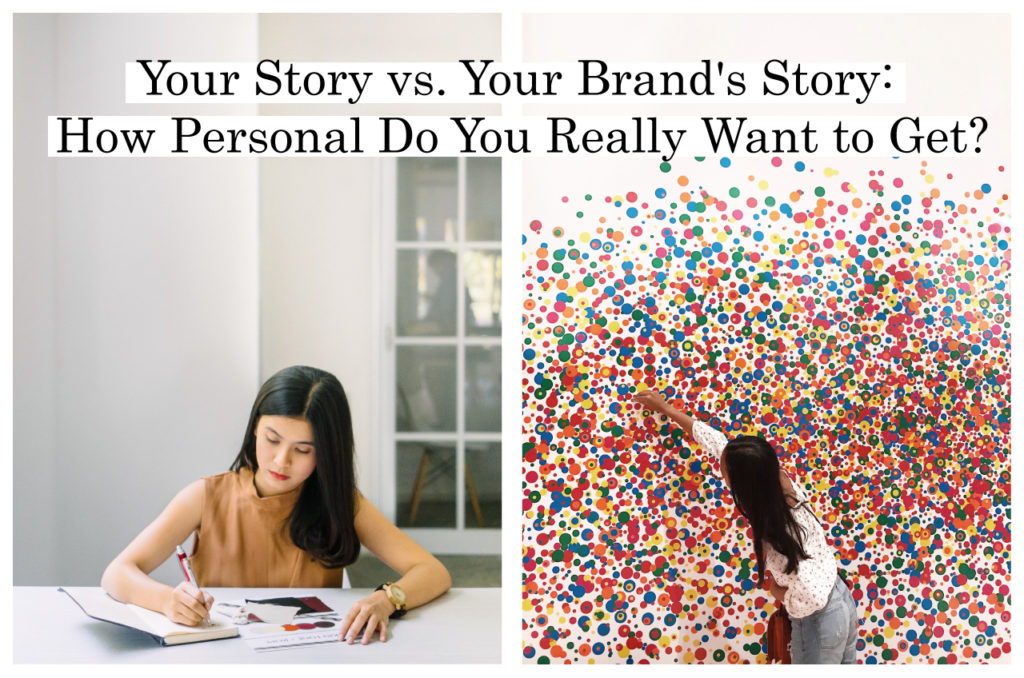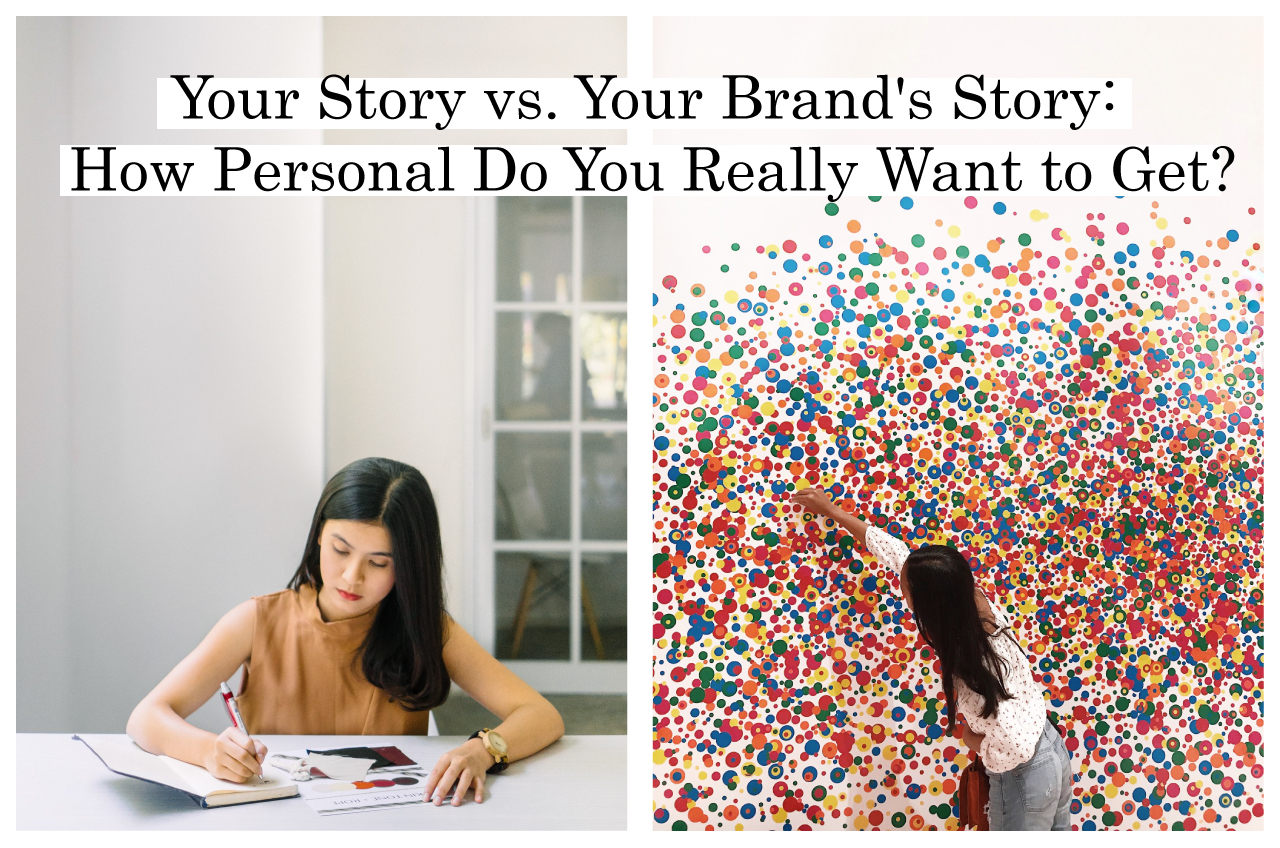Doesn’t it feel like Instagram has brainwashed everyone into thinking they are a personal brand? I mean LinkedIn definitely started the trend, but Instagram made personal-meets-business-meets-Lifestyle a defining way of connecting with other humans, and I know it’s left a lot of entrepreneurs wondering “Can’t I just ‘do the thing’ without trying to make it look like I’m living a fantasy luxury lifestyle on Instagram?”
There’s so much talk about getting vulnerable, whether that’s posing in your underwear or talking about your deepest traumas, and sharing your story feels required these days, but bulldozing your own boundaries just to get a few more likes and comments probably isn’t actually helping your business’s bottom line, is it?

It’s great to share your story, but you’ve got to do it intentionally, and in the right ways in the right order in order for it to actually serve your business.
Your Personal Brand Story vs. Your Brand StoryFirst, we need to get some terminology clear. When I talk about your story or your personal brand, that’s your life journey, your experiences – everything from falling down and scraping your knee as a child to who you studied under and why. When I talk about your brand story, that’s the story of your business, and it’s often not about you as much as your customers. Once you understand this distinction, where and how you use your personal brand vs. your brand’s story will become very clear, and the anxiety of oversharing to crickets will fade away.
Brand Story
The very best resource I can refer you to on this topic is Story Brand written by Donald Miller. Every entrepreneur should work through that book at least once. The idea here is to tell what you do, for whom, and how they’re transformed. This is what goes on your homepage on your website, in your emails, and on the branded business profiles you’ve set up on social media.
example: We help women defy aging, gracefully. For the woman who knows skincare alone won’t keep aging at bay, we offer the latest results-focused treatments in a luxurious environment.
Your Personal Brand Story
This is your set of personal experiences and stories that led you where you are within your business today. This goes in your “about me” and on social media posts and in follow-up emails. The point here is that your brand story is a bit more personal, and it deserves to be told to those who want to hear it, generally after they’ve shown some interest in that topic. Said another way, your brand story is an introduction at a networking event, and your personal brand story is best told over a coffee date. It’s not what you lead with, it’s what you build the relationship with. Always lead with what’s in it for them, then build trust that you’re the one to help them create the changes they’re looking for, because you have already been on this journey (“this journey” being the your personal brand story).
example: I was so tired of buying skincare products that didn’t work, and as a doctor, I knew why: there’s only so much an at-home skincare regimen can do. So I opened a practice a bit selfishly – I wanted access to all the best treatments, and I wanted to be able to share what I’ve found to be really effective with some of my best girlfriends. Today I have over 5,000 ‘girlfriends’ (and some ‘guyfriends’ too) who come to me to help them defy aging with grace and ease.
When & Where to Share
Your personal profiles on social media should link to your business pages, and in most cases (non-corporate businesses) vice versa. People want to be able to see who is behind a brand, and the people in your social circles are actually more interested in what you do for a living than you would expect. But the content and way in which you share things on these 2 types of profiles needs to be differentiated.
Your Personal Profile:
- your personal stories and lessons
- your reason for doing the work you do – your why
- Things you’re excited about
- photos of your family, dogs, vacations, and hobbies
Your Business Profile:
- your brand story and client transformation stories (testimonials)
- the values of your business (and ideal clients) and mission in the world
- Things your ideal clients (or their clients) would be excited about
- photos of your staff, your office, your office parties, and your customers
Keeping these 2 angles to your content separated will allow your clients and friends & family to engage with you how they most feel comfortable and will allow you to establish some boundaries that keep you feeling comfortable and confident about what you’re sharing.
If you want to dive a little deeper, consider these questions:
- What tone (read: words) do you use on social media? Should your business, in speaking to your ideal client avatar, use the same tone?
- example: I say “hey ya’ll” but my business does not, because that’s something that comes naturally from where I grew up and is a part of who I am, but it’s not something that all of my dream clients connect to positively. I would caution you here that this doesn’t mean you need to take all of the personality out of your brand (or speak super formally), but it does mean thinking about what attracts the right client, and tailoring your business brand to do just that. Your personal brand doesn’t have to be as ruthlessly edited or optimized – it can be you, truly.
- What are your personal brand colors (read: filters) and font choices – are they the same as your business brand?
- example: I’ve been enjoying playing around with the new font and styling options on Instagram and Facebook lately, but my brand keeps it consistent with colors and fonts so that it always looks and sounds like us. Another example is that I try to stay within my brand’s color schemes when I post photos on my business Instagram (often this means tailoring my wardrobe to include those brand colors), but I’m less strict with my personal feed.
The Next Step
Once you have your personal and business brands well-defined, the next step is to create a content calendar for each. You want to tell similar stories in different ways across both your personal and branded profiles so that the message is cohesive, but tailored to your 2 different audiences.

